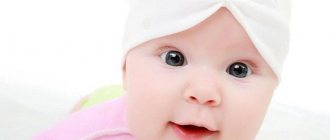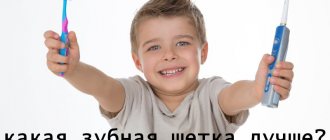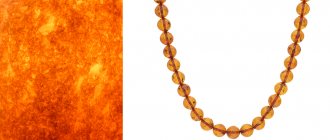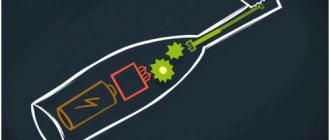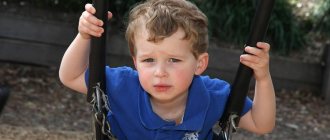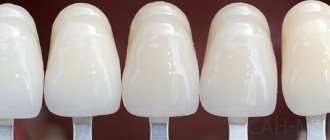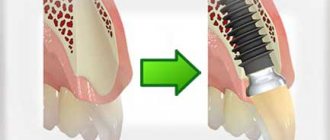What is an orthodontic pacifier?
The main feature of this nipple is its shape - part of it is beveled and flattened, which corresponds to a more natural position in the child’s mouth. Why did they do this? According to these parameters, it corresponds to the anatomical shape of the mother's breast when feeding the baby. This is how you can achieve the most correct grip with your mouth, as well as the desired formation of your bite.
What is an orthodontic pacifier used for? Like any other pacifier, it is given to the child to calm him down, stop crying, and whims. But due to its shape, it also additionally stimulates the development of the jaw apparatus, strengthens joints and has a positive effect on the position of future teeth.
Pacifiers: harmful to the baby
Prolonged sucking on a pacifier, bottle nipple, or thumb can cause a gap to appear between the front teeth or the development of an open bite, in which the jaws do not close completely.
A pacifier leads to underdevelopment or, on the contrary, too rapid growth of the lower jaw - as a result, it will move forward or be too far relative to the upper jaw.
Also, a bad habit leads to incorrect position of the tongue when swallowing. Normally, the tongue is located at the bottom of the jaw, and not between the front teeth.
Correction of the bite with reliable metal braces - 75,000 rubles.
All inclusive! Preparation and treatment of the oral cavity, consultation with an orthodontic specialist, installation and adjustment of orthodontic structures. Color options available for little ones!
Free consultation with an orthodontist +7 (495) 789-39-31 or write to us
How to make a choice?
When entering a store that sells baby products, it’s easy for new parents to get confused. After all, the offer of even just pacifiers represents a huge number of models, colors, sizes, materials, etc. Let’s try to determine what you need to pay attention to when choosing a baby pacifier for the first time:
- The material from which its main part is made is the one that the baby will directly suck on. Recently, manufacturers have settled on two options - latex and silicone. The first is more natural, but has a slight aftertaste that some children do not like. The second one has hypoallergenic characteristics, is colorless and odorless, elastic and lasts longer.
- The shape of the nipple can also be different - round, beveled, flat, etc. We point out that the orthodontic one is the most acceptable, since it completely follows the shape of the breast and best matches the natural position of the child’s tongue and jaws.
- The size of the pacifier is important - you need to pay attention to the age of the baby for whom it is intended, indicated on the label. So, they are usually divided for children up to six months, up to one year and up to two or three years. It is obvious that even if you buy a pacifier of the correct shape, but a larger or smaller size, you will harm the development of the bite.
- Color - here the choice remains only with the parents, since for the baby it will not matter yet. The only thing doctors pay attention to is the wish that it be light, neutral tones. After all, a bright object in the child’s visibility range can distract his attention.
- The price of such products fluctuates approximately in the same ranges and differs only depending on the brand, brand, and popularity of the manufacturer.
There are also nipples for bottles of different shapes, including orthodontic ones. If your baby will be fed formula, then it makes sense to choose it according to the specified parameters. This is the only way to be sure that many dental and speech therapy problems will be avoided in the future.
Separately, it is worth pointing out the duration of use of pacifiers made of different materials. Silicone ones are resistant to temperature changes and last much longer. Although over time they may begin to crack and lose elasticity. Latex ones are more fragile, a child can easily bite through them. In addition, such products often begin to stick together and need to be replaced with new ones.
Should I worry if my pacifier has become indispensable?
First off: what's the difference?
It's actually simple. A nipple is a product that is shaped like a female nipple and is placed on a bottle. That is, there is a hole in the nipple, and it is intended for feeding the baby. A pacifier is also a product that resembles a nipple, but there is no hole in it, and you cannot feed your baby through it. A child can only suck a pacifier and a pacifier, nothing else. Therefore, I will consider them together.
Now about the myths. There are quite a lot of them on the Internet and I will explain the most common ones about nipples (pacifiers).
The pacifier “spoils” the bite.
True, with one “but”.
A pacifier is one of the reasons for the formation of primary malocclusion pathologies in children if:
- the child is over 1 year old (all primary incisors have erupted, and by 3 years all primary teeth have erupted)
- use of the pacifier is unlimited (24 hours a day)
- with prolonged use of a pacifier, almost 80% of children develop an abnormal primary bite (the primary teeth of the upper jaw move forward)
- weaning from her was quick
For example, if not properly weaned from a pacifier, a child may start thumb sucking. And this is already a bad habit.
According to one study, in children who already have primary malocclusion pathology, with proper and timely weaning from the pacifier, the dental system can recover on its own (65-83%). In addition, the presence of such a bite of primary teeth does not mean that the permanent bite is not formed correctly.
A small conclusion: if you use the pacifier correctly, following the recommendations of doctors, indications and contraindications, you can avoid harmful consequences.
The pacifier calms the baby.
Of course it's true.
The pacifier helps satisfy the sucking reflex, the baby calms down and falls asleep, and sleeps more peacefully at night with it. And mommy can absolutely use this. Of course, you can use it less often during the day.
The pacifier disrupts breastfeeding, problems arise, and a pacifier should not be used at all during breastfeeding.
True in some situations.
Sucking a mother's breast is a serious job for a child: you need to latch onto the breast correctly (the pacifier has a smaller latching area), actively suck on the breast to get enough milk (it is easier to suck on the pacifier, since the hole/s in it are larger and the milk flows faster).
Indeed, when there is not enough milk, the baby is supplemented with formula, then you need to choose the right pacifier (and continue to apply it to the breast in order to normalize lactation), since the child will not want to strain and will suck the breast sluggishly, will receive less milk, and therefore will worry more often. The baby may also bite and cracks may appear on the nipples. In this case, it is recommended not to give a pacifier to a healthy child unless indicated until breastfeeding is established (this is up to 1 month).
The pacifier can be used, but according to indications and for a limited time. Therefore, in the maternity hospital, the mother should consult with a doctor: is a pacifier necessary, how to maintain lactation, how correctly the child should latch onto the breast, what feeding technique and care for the mammary glands.
The risk of developing acute otitis media increases when using pacifiers.
This opinion is based on one study conducted in Finland with children aged 7-18 months, which found that the risk of developing acute otitis media (middle ear infection) was 29% lower in children who did not suck a pacifier. According to some experts, this depends on changes in pressure in the ears and leads to the accumulation of fluid inside the middle ear, the infection of which leads to the development of the disease.
I have a counter question: how long should a child suck a pacifier per day for a pressure shift to occur? To this I can only say one thing: you need to use the pacifier correctly.
A pacifier in the mouth is a source of infection.
Is it true.
It's a matter of hygiene:
- wash the pacifier once a day with baby soap or a special care product
- be sure to sterilize by boiling or in a bottle sterilizer before first use and in subsequent use
- use a container to store it
- If the pacifier falls on the floor, do not lick it! Rinse under running water or rinse with boiling water
- monitor the condition of the pacifier surface (presence of damage). If there is even one small scratch, change the pacifier. Uneven surfaces serve as a breeding ground for germs
A pacifier “slows down” a child’s development.
The sucking reflex is an important stage in the development of a child and, accordingly, it is temporary. In children under one year of age (after the reflex physiologically fades away), problems may arise if the sucking reflex is dissatisfied. But every mother should understand that the breast is the best option for the child, so a pacifier is a backup option.
Also, babies grow up to be more sociable and sociable (unless prolonged pacifier sucking has led to malocclusion and speech impairment).
It is difficult to wean a child off a pacifier, as it is addictive.
Is it true.
A child's sucking reflex is pronounced from birth and only by the age of 3 it fades away completely. At this time, it is important to gradually and with minimal stress for the child wean him off the pacifier, as this can then become a habit.
Some doctors believe that it is easiest to wean a child at the age of 1-1.5 years and does not need to be delayed until 3-4 years. The following is a list of when it is necessary to wean a child off a pacifier:
- child's age 3 years
- the child sucks a pacifier for a long time during the day with breaks for food
- the child does not want to communicate with peers and play interactive games
- The doctor discovered a speech delay in the child
As for the weaning process itself, there are also several rules:
- you need to start during a period of complete health, and in the absence of other stressful situations (kindergarten, potty training, sleeping separately, moving, etc.)
- There is no need to smear the pacifier with something tasteless, spicy or sour - the child can get this product into his eyes and nose, which can lead to an allergic reaction and other undesirable consequences
- Gradually cutting off the rubber part of the pacifier is also not an option, since the child may bite off a piece of it
What should you do then? There are many different methods on the Internet, but they are all divided into quick and gradual methods.
The quick method is tougher, but also the most reliable: at one point the mother simply hides it and doesn’t show it again, doesn’t remind her of the pacifier. This method is difficult, because not only the child sheds tears and throws hysterics, but the parents also suffer while looking at it. Also, parents need to stand firmly on their own and not make concessions to the child.
The gradual method is more loyal and calm. The point is to distract the child as often as possible, keep him busy with activities and games without the presence of a pacifier nearby, leading to the point that the child completely refuses or forgets about it.
When a child needs a pacifier only before falling asleep, you need to choose another way to put the child to sleep: read fairy tales, conduct a dialogue with the child.
Another method is to give it to another small child (baby). Not all, but many children are ready to part with their pacifier for the benefit of another child.
A child's love for a pacifier can develop into bad habits.
Smoking. Some psychologists argue that smoking is a consequence of an unsatisfied sucking reflex. That is, it’s the other way around - insufficient use of a pacifier led to smoking. Or another bad habit - biting your nails.
The habit of biting nails occurs in people who do not tolerate stress, tension and anxiety well. This is their way to calm down and it has nothing to do with the pacifier.
Be healthy!
Sincerely, Oksana Olegovna.
Popular models
In the store you can find the following famous brands:
- Avent (Avent) - silicone products are odorless and tasteless. Specially shaped wings reduce pressure on the child’s gums and are considered a very convenient option. Manufacturers have thought through ensuring daily hygiene by creating a separate cap for each product. They can also be washed in the dishwasher or sterilized in special devices.
- Bibi (Bibi) - there are varieties of latex and silicone models. Clever holes on the wings of the base are designed for better air circulation, which prevents irritation of the skin around the mouth. The quality of the products is such that they do not deteriorate when repeatedly boiled. What parents will especially like is the opportunity to choose interesting and original colors with inscriptions or drawings.
- NUK (Nuk) - the nipple is made from a particularly soft material, and its shape has a good recess, which provides space for the tongue. Sizes are designed for children from toddlers to three years old. Made of latex in such color options as gold, red and blue.
- Dr.Brown (Doctor Brown) - silicone models without taste or smell. The manufacturer offers to purchase a set of two products at once. The comfortable shape and pleasant material help the child quickly get used to the device and happily accept it. The sizes are larger for newborn babies.
- Tommee tippee (Tommy tippee) - silicone models with an emphasis on breathable wings at the base. It is thanks to them that it is easy for the child to hold the pacifier in his mouth and at the same time the skin does not become irritated from increased salivation. Parents will also like the original design and colors.
- Canpol (Kenpol) - the manufacturer offers the widest range of nipples made of latex and silicone. At the same time, various shapes, colors, sizes will help you choose the most suitable one for your baby.
The benefits of pacifiers for correcting malocclusion
- formation of the correct bite,
- normalization of jaw position,
- no allergic reactions: nipples are made from hypoallergenic materials using modern equipment,
- supporting the tongue in a natural position - reducing its pressure on the front teeth,
- protection against the appearance of open bite, gaps between the front teeth, upper and lower jaws,
- formation of the correct swallowing reflex,
- development of normal nasal breathing,
- getting rid of bad habits such as thumb or pacifier sucking.
The ease of use of orthodontic pacifiers makes them as useful and comfortable as possible for both parents and children. Their use helps prevent the formation of bad habits that have a detrimental effect on the development of the baby’s bite.
Metal braces Empower (USA) - RUR 80,000!
All inclusive! Preparation and treatment of the oral cavity, consultation with an orthodontic specialist, installation and adjustment of orthodontic structures. The price is for 1 jaw. Consultation with a doctor is free! Call now: +7 (495) 789-39-31
Malocclusions can cause problems with appearance and posture, provoke respiratory and digestive disorders, and impair diction. Not only orthodontic plates will help you avoid all this, but also maximum attention to the child’s health and, of course, parental love!
Price
| Service name | Price |
| Self-ligating braces Damon Q (Ormco, USA) | 90,000 rub. |
| Self-ligating Empower (American Orthodontics, USA) | 65,000 rub. |
All prices for services
How to properly give an orthodontic pacifier?
In order to preserve all the thoughtful nuances of the chosen model and provide the child with maximum comfort when using it, you need to adhere to certain recommendations:
- Give the nipple with the beveled edge down, which will allow the tongue to move more. Make sure your baby doesn't turn it over in his mouth.
- Be sure to process, wash and sterilize the product every day.
- Before giving a pacifier to a child, you need to carefully inspect it for cracks or other defects.
- It is advisable to replace silicone models with new ones every month, despite the fact that it has not deteriorated externally. But latex ones can be thrown away once every two months.
- Doctors emphasize that even a child should be weaned off an orthodontic pacifier at the age of one.
- Try to use this “helper” only when necessary, without abusing it. When the child falls asleep, you need to carefully remove the pacifier, because this is not a night toy.
Video: how to choose a pacifier?
At what age does a child develop a bite?
The bite is formed in children from the moment they are born.
And it goes through several stages:
- 0-6 months. During this period, the correct development of the jaws is important, as they prepare for the appearance of the first teeth.
- 6 months – 3 years. Formation of temporary occlusion.
- 3-6 years. Formed temporary occlusion, preparing the jaws for the appearance of permanent teeth.
- 6-12 years old. Formation of a mixed dentition due to the replacement of baby teeth with permanent ones.
- 12-15 years old. Formation of a permanent bite.
Speaking about whether the pacifier affects the child’s bite, we must not forget that the process of jaw formation is long and it begins from the moment the child is born, and not with the appearance of the first teeth. Therefore, it is important to monitor their condition until adolescence.
Advantages and disadvantages of pacifiers
Like everything else, pacifiers have their supporters and opponents, who give a lot of arguments for and against. Let's look at the most popular benefits of pacifiers for newborns.
- Newborns have a very strong sucking reflex, which manifests itself even in the womb. If for some reason the child does not feed on breast milk, but on formula, the nipple becomes a substitute for the breast.
- Even with breastfeeding, the mother's breast may not be enough for the baby. In this case, the pacifier will simply satisfy his sucking reflex, there is nothing wrong with that.
- The pacifier helps the baby calm down faster, so it is recommended for restless children.
- A pacifier can distract a child from unpleasant procedures, such as changing a diaper, washing or changing clothes, as well as when visiting a doctor.
- If a child is used to sleeping with his mouth open, a pacifier will come in handy during a walk, especially in winter: this way the child will not “swallow” cold air.
Now let's talk about the cons. Opponents of pacifiers believe that a pacifier can literally disorient a child. Its shape is different from the shape of a woman's breast, so when feeding, the baby may begin to latch onto the breast incorrectly, which causes discomfort to the mother and sometimes impairs the flow of milk. If you get too used to the pacifier, it will not be so easy to wean your child off the pacifier. And if the child has already started teething, an incorrectly selected pacifier can negatively affect the bite.
When to use a pacifier
You need to give your child a pacifier if he is in a stressful situation - a car ride, a doctor's examination, a long walk or getting dressed/undressed.
The pacifier helps the baby relax and calm down, and can be used before bed.
Instead of rocking your baby in your arms or on a fitball, or lying down in an uncomfortable position for breastfeeding, cover your baby with a blanket, give him a pacifier and pat him on the back - sleep will not take long to come.
At two months of age, when it’s time for colic, a pacifier will also come in handy. When sucking it, saliva is produced, which has a beneficial effect on the digestive system and intestinal motility, which means that the passage of gases is easier and the tummy stops bothering the baby.
If you notice that your baby or toddler constantly sucks on his fist, then it is better to give him or her a pacifier, it will be much more hygienic, and then it will be easier to remove the pacifier from the mouth than a fist or finger.
Why doesn't a child take a pacifier?
There are several reasons for giving up a pacifier. They are simple, quite understandable, and easy to fix.
- Wrong size . As already mentioned, each pacifier is marked with the age for which it is designed. Don't neglect this information. Perhaps the pacifier is too big and is simply falling out of the mouth.
- "Tasteless" material . Some babies prefer soft, warm latex nipples, while others prefer elastic, hard silicone ones. Try both options, then you will understand which is preferable for your child.
- Inconvenient shape . This is where some parents have to collect a whole collection of different forms before finding the one they need.
Useful tips
In addition to the criteria for making the right choice, parents need to know how to give this hygiene device to their child. A reasonable approach will eliminate the likelihood of undesirable consequences:
- Before your baby gets acquainted with the device for the first time, it is necessary to boil (sterilize) the pacifier. This will prevent the development of infectious diseases of the oral cavity;
- After 4 - 6 weeks of operation, you need to replace the old device with a new one. If the pacifier is made of latex, it needs to be changed much more often;
- For safe use of the pacifier, you should purchase a special case. You should not put a pacifier on the child’s neck, tying the device with a ribbon or elastic band;
- Do not lick the pacifier before giving it to your baby. The saliva of adults contains microorganisms that can harm the child's body.
If the child refuses to take the pacifier, you should not despair or insist. After some time, the procedure is usually repeated, but it is better to offer a new pacifier each time. If the baby refuses for several months, you should simply come to terms with the child’s choice.
The problem of how to accustom a child to a pacifier is not worth the mother’s or child’s nerves. It is important to monitor the baby’s reaction and understand when he is capricious and when he requires more communication with his mother. Thus, a pacifier is just a maternal assistant, and not an alternative to parental affection and tenderness.


